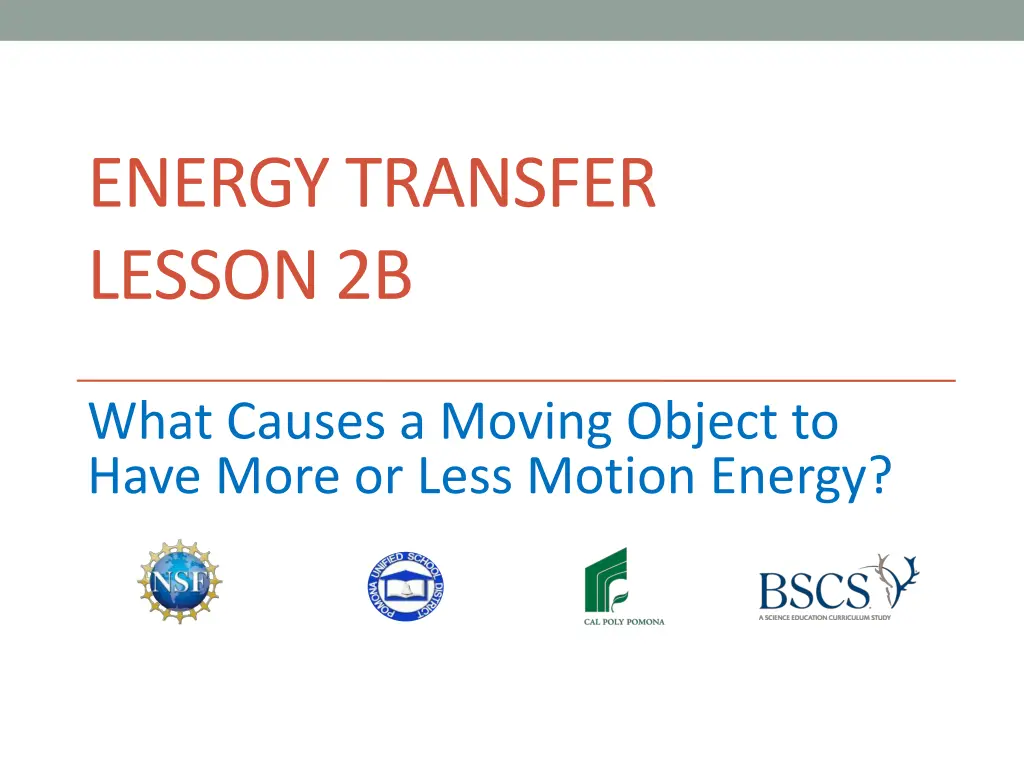
Understanding Motion Energy in Moving Objects
Explore the concept of motion energy in moving objects through an investigation with ramps and marbles. Discover how the speed of an object affects its motion energy and learn to analyze data to draw conclusions. Engage in hands-on activities and critical thinking to deepen understanding.
Download Presentation

Please find below an Image/Link to download the presentation.
The content on the website is provided AS IS for your information and personal use only. It may not be sold, licensed, or shared on other websites without obtaining consent from the author. If you encounter any issues during the download, it is possible that the publisher has removed the file from their server.
You are allowed to download the files provided on this website for personal or commercial use, subject to the condition that they are used lawfully. All files are the property of their respective owners.
The content on the website is provided AS IS for your information and personal use only. It may not be sold, licensed, or shared on other websites without obtaining consent from the author.
E N D
Presentation Transcript
ENERGYTRANSFER LESSON 2B What Causes a Moving Object to Have More or Less Motion Energy?
What Did You Predict? Which marble has the most energy the faster marble or the slower marble? Who predicted that the faster marble has the most energy? Who predicted that the slower marble has the most energy?
Todays Focus Question What causes a moving object to have more or less motion energy? Sentence starter: I think a moving object has [more motion energy/less motion energy] when ______. My evidence is ___________.
Review: Investigating Ramps and Marbles Data we collected in our ramp-and-marble investigation: 1. The speed of the marble (faster or slower) 2. The distance the Styrofoam block moved 3. The height of the ramp Let s examine our data and evidence to help us answer today s focus question!
Sample Data from Our Investigation Use the data from your handout to answer these questions: Which marble was on the higher ramp the faster marble or the slower marble? Which marble was on the lower ramp? Which marble moved the Styrofoam farther? Which marble do you think has the most motion energy? Why?
Investigating Ramps and Marbles Key science idea: When an object moves faster, it has more motion energy. Our evidence: The faster marble moved the block of Styrofoam farther than the slower marble.
Todays Focus Question What causes a moving object to have more or less motion energy? Review the answer you wrote in your science notebook last time. Decide whether to make changes to your answer or write a new answer. Make sure to use complete sentences and include your evidence and reasoning. (Hint: What do you know about a marble s speed and energy?)
A New Way to Share Our Ideas Next we ll use the CCCR strategy to improve our answers to the focus question. CCCR stands for ... Consider Contribute Consult Revise
A New Way to Share Our Ideas Work with a partner to revise your ideas: Partner 1 (Reader): Read the answer you wrote in your notebook to the focus question. Partner 2 (Listener): Listen carefully and think about these questions: Does the answer make sense? Do the ideas answer the focus question? Then switch roles: Partner 2 is the reader, and Partner 1 is the listener.
A New Way to Share Our Ideas Partner 1 (Ask for feedback): Ask Partner 2 how you could improve your answer to the focus question. Was anything confusing about my answer? How can I make my answer clearer? How can I make my answer more accurate? Partner 2 (Give feedback): Share ideas for improving Partner 1 s answer. Use these sentence starters: I agree/disagree with your answer because ______. I think if you said _____________, it would make your answer clearer/more accurate. Then switch roles: Partner 2 asks Partner 1 for feedback.
Revise Your Answers How could you revise your answer to make it better and more accurate? Think about the ideas your partner shared for improving your answer. Are any of your partner s ideas better or more accurate than your original ideas? Using a different-colored pencil, revise or rewrite your answer to the focus question.
Key Science Ideas Energy is all around us, and we can detect it with our senses. Moving objects have motion energy. A marble will roll down a higher ramp faster than it will roll down a lower ramp of the same length. When a faster-moving marble collides with an object, it will push the object farther than a slower-moving marble on a lower ramp would. Therefore, a faster-moving object has more motion energy.
Marbles, Motion, and Energy Marbles aren t the only objects with motion and energy! Have you ever ridden a bicycle down a hill? Did you have to pedal your bike to move down the hill? Describe your speed and energy as you rode down the hill.
Next Time In the next lesson, we ll read a story about two friends who are riding their bikes. One of the boys is riding very fast down a hill, and the other is waiting at the bottom. What do you think will happen? What does this scenario have to do with motion and energy? Stay tuned!






















